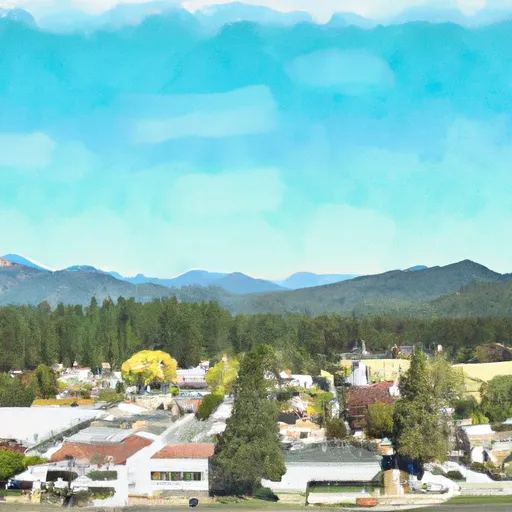-
 Snoflo Premium
Snoflo Premium
Get unlimited access to all our content
With no Ad interruptions! - Start Your Free Trial Login with existing account
Hume
Eden Index
Climate
8.9
•
Recreation
7.8
•
Community
0.9
•
Safeguard
6.5/10

Hume, California is a small unincorporated community located in Fresno County, nestled in the Sierra Nevada Mountains. The region features a Mediterranean climate, characterized by hot, dry summers and cool, wet winters. Average temperatures range from the mid-80s Fahrenheit in summer to the mid-40s in winter.
Hydrologically, Hume is situated in the Kings River watershed, which offers a diverse range of water resources. The Kings River is a significant water source for the area, providing opportunities for water-based activities such as fishing, boating, and swimming. The region also boasts several picturesque lakes, including Pine Flat Lake and Shaver Lake, where visitors can enjoy various water sports and camping.
Outdoor enthusiasts will find plenty of recreation opportunities in Hume and its surrounding areas. The Sierra National Forest, with its expansive network of trails, invites hikers, mountain bikers, and horseback riders to explore its scenic beauty. The region is also known for its excellent birdwatching, with many avian species calling the area home or passing through during migration.
In summary, Hume, California offers a pleasant Mediterranean climate, abundant water resources, and a variety of outdoor recreation opportunities that cater to nature lovers and adventure seekers alike.
What is the Eden Index?
The Snoflo Eden Index serves as a comprehensive rating system for regions, evaluating their desirability through a holistic assessment of climate health, outdoor recreation opportunities, and natural disaster risk, acknowledging the profound impact of these factors on livability and well-being.
Climate Health Indicator (CHI): 8.9
Hume receives approximately
1000mm of rain per year,
with humidity levels near 73%
and air temperatures averaging around
9°C.
Hume has a plant hardyness factor of
7, meaning
plants and agriculture in this region tend to thrive during the non-winter months.
By considering the ideal temperature range, reliable water supplies, clean air, and stable seasonal rain or snowpacks, the Climate Health Indicator (CHI) underscores the significance of a healthy climate as the foundation for quality living.
A healthy climate is paramount for ensuring a high quality of life and livability in a region, fostering both physical well-being and environmental harmony. This can be characterized by ideal temperatures, reliable access to water supplies, clean air, and consistent seasonal rain or snowpacks.
Weather Forecast
Streamflow Conditions
Tulare-Buena Vista Lakes
Area Rivers
Tulare-Buena Vista Lakes
Snowpack Depths
Tulare-Buena Vista Lakes
Reservoir Storage Capacity
Tulare-Buena Vista Lakes
Groundwater Levels
Recreational Opportunity Index (ROI): 7.8
The Recreational Opportunity Index (ROI) recognizes the value of outdoor recreational options, such as parks, hiking trails, camping sites, and fishing spots, while acknowledging that climate plays a pivotal role in ensuring the comfort and consistency of these experiences.
Access to outdoor recreational opportunities, encompassing activities such as parks, hiking, camping, and fishing, is crucial for overall well-being, and the climate plays a pivotal role in enabling and enhancing these experiences, ensuring that individuals can engage in nature-based activities comfortably and consistently.
Camping Areas
| Campground | Campsites | Reservations | Toilets | Showers | Elevation |
|---|---|---|---|---|---|
| Buckeye Flat - Sequoia National Park | 28 | 2,828 ft | |||
| Dorst Creek - Sequoia National Park | 218 | 6,751 ft | |||
| Upper Stony Creek | 18 | 6,521 ft | |||
| Eshom | 23 | 4,843 ft | |||
| Buck Rock | 5 | 7,730 ft | |||
| South Fork - Sequoia National Park | 10 | 3,656 ft | |||
| Stony Creek | 49 | 6,425 ft | |||
| Lodgepole - Sequoia National Park | 214 | 6,726 ft | |||
| Eastern Big Meadow Road | 24 | 7,622 ft | |||
| Potwisha - Sequoia National Park | 43 | 2,101 ft |
Nearby Ski Areas
Catastrophe Safeguard Index (CSI):
The Catastrophe Safeguard Index (CSI) recognizes that natural disaster risk, encompassing floods, fires, hurricanes, and tornadoes, can drastically affect safety and the overall appeal of an area.
The level of natural disaster risk in a region significantly affects safety and the overall livability, with climate change amplifying these risks by potentially increasing the frequency and intensity of events like floods, fires, hurricanes, and tornadoes, thereby posing substantial challenges to community resilience and well-being.
Community Resilience Indicator (CRI): 0.9
The Community Resilience Indicator (CRI) recognizes that education, healthcare, and socioeconomics are crucial to the well-being of a region. The CRI acknowledges the profound impact of these elements on residents' overall quality of life. By evaluating educational resources, healthcare accessibility, and economic inclusivity, the index captures the essential aspects that contribute to a thriving community, fostering resident satisfaction, equity, and social cohesion.

